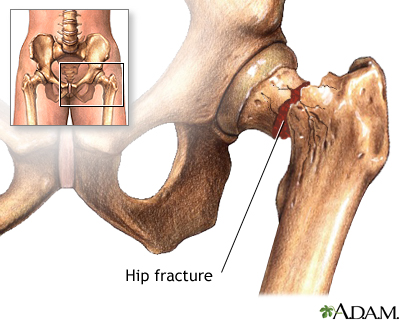 A complete or incomplete break in the head of the femur, the major bone In the hip joint.
A complete or incomplete break in the head of the femur, the major bone In the hip joint.
In the United States, hip fractures are the most common broken bone that requires hospitalization; about 300,000 Americans are hospitalized for a hip fracture every year. Hip fractures are generally separated into two types of fractures:
- Femoral Neck Fractures
- Intertrochanteric Hip Fractures
BODY PARTS INVOLVED
- Femur (the large bone extending from the knee to the hip).
- Acetabulum (hip socket in bony pelvis).
- Hip joint.
- Soft tissue around the fracture site, including muscles, nerves, tendons, ligaments, periosteum (covering to bone), blood vessels and connective tissue.
Causes
Direct blow or indirect stress to the hip joint. Indirect stress may be caused by twisting or a violent muscle contraction. In older adults, a hip fracture is most often a result of a traumatic event, such as falling, and weak bones.
Signs & Symptoms
- Severe pain in the hip.
- Inability to stand.
- Swelling and bruising around the fracture.
- Visible deformity if the fracture is complete and the bone fragments separate enough to distort normal body contours.
- Tenderness to the touch.
- Numbness or coldness in the leg and foot if the blood supply is impaired or nerves are injured.
Treatment
Follow your doctor's instructions. Instructions are supplemental. Surgery is almost always the best way to repair a hip fracture. Doctors typically use non-surgical alternatives, such as traction, only if you have a serious illness that makes surgery too risky. The type of surgery you have generally depends on the part of the hip that fractured, the severity of the fracture and your age.
- Immobilization will be necessary. In hip fracture, the fractured bone is usually fixed and held with surgical steel pins or nails. A rigid cast is placed from pelvis to knee.
- Use frequent ice massage after the cast is removed. Fill a large Styrofoam cup with water and freeze. Tear a small amount of foam from the top so ice protrudes. Massage firmly over the injured area in a circle about the size of a softball. Do this for 15 minutes at a time, 3 or 4 times a day.
- Apply heat instead of ice, if it feels better. Use heat lamps, hot soaks, hot showers, heating pads, or heat liniments and ointments.
- Take whirlpool treatments, if available.
- Massage gently and often to provide comfort and decrease swelling.
MEDICATION
Your doctor may prescribe:
- General anesthesia to make joint manipulation possible.
- Narcotic or synthetic narcotic pain relievers for severe pain.
- Stool softeners to prevent constipation due to inactivity.
- Acetaminophen for mild pain.
- Antibiotics to fight infection following surgery.
Home Diet
- Drink only water before manipulation or surgery to treat the fracture .Solid food in your stomach makes vomiting while under general anesthesia more hazardous.
- During recovery ,eat a well-balanced diet that includes extra protein, such as meat, fish, poultry, cheese, milk and eggs. Increase fiber and fluid intake to prevent constipation that may result from decreased activity.
Prevention Tips
You can reduce your risk of a hip fracture by taking steps to prevent osteoporosis. Women are more likely than men are to develop osteoporosis; however, both women and men can take steps to prevent osteoporosis. These steps can help you prevent a hip fracture by slowing bone loss:
- Build your strength with a good conditioning program before beginning regular athletic practice or competition. Increased muscle mass helps protect bones and underlying tissue.
- Weight-bearing exercises, such as walking, apply tension and pressure to your muscles and bones, encouraging your body to increase bone density to meet the additional stress. Exercise also increases your overall balance and strength, making you less likely to fall. High-impact exercises, such as those involving running or jumping, aren't recommended if you have weak bones, as they may increase your risk of a fracture or injury.
- Use appropriate protective equipment, such as hip pads, when competing in contact sport.
- Ensure an adequate calcium intake (1000mg to 1500mg a day) with milk and milk product or calcium supplements.
- Preserve your bone density by avoiding the excessive use of alcohol and by not smoking.
- If you're older, wear thinner, hard-soled, flat shoes. Resilient-soled athletic shoes may impair your balance and contribute to falls. Avoid wearing high heels or sandals with light straps. Avoid wearing shoes that are either too slippery or too sticky.
- Poor eyesight is a possible cause of falls. If you're having trouble seeing, have your eyes checked. Wearing proper glasses and being able to see well around your home makes it more likely that you'll see objects that you might trip over.
No comments:
Post a Comment